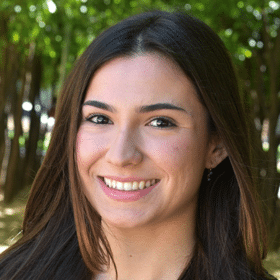Frozen Section of Melanoma: Accuracy at an Experienced Institution
Tissiana Vallecillo
| Mentor | Linda Yin, MD, BA, Eric Moore, MD, and Santiago Romero-Brufau, PhD |
|---|---|
| Award Type | Medical Student Award |
| Institution | MAYO Clinic, Rochester, MN |
| Donor Support | The Craig P. Merkel and James K. Saunders Memorial Award |

Patients with melanoma of skin in the head and neck region are at high risk for death from their cancer despite surgical treatment. Currently, treatment consists of surgical removal of the tumor and a biopsy of the first lymph node that receives drainage from the affected area. This lymph node is called the sentinel lymph node. If the sentinel lymph node biopsy is positive, patients have the choice of undergoing further surgery to remove all lymph nodes that drain the affected area, or to keep an eye on the remaining lymph nodes through repeat exams with their doctor and ultrasound tests. Studies in melanoma do not show that removing the rest of the draining lymph nodes decreases the risk of death from melanoma, but it does decrease the risk of cancer coming back in the neck. In discussion with their surgeons, many patients opt to undergo repeat ultrasounds and avoid another procedure to remove the rest of the lymph nodes given the limited benefits of doing additional surgery. However, this is not always a good option for patients that live far away from medical care. Frozen section is a pathology technique that allows for analysis of tissue samples immediately while the patient is still asleep under anesthesia, returning a diagnosis in 20-30 minutes. However, detecting melanoma on frozen section analysis has traditionally been challenging. This study will investigate the accuracy of frozen section diagnosis in melanoma in an institution that performs this testing regularly. If it proves to be accurate, then it would be possible to use frozen section diagnosis to determine whether the sentinel lymph node is positive, and whether removal of the rest of the lymph nodes is warranted. If the latter can be done under the same surgery, then more patients may elect to choose this option. It could potentially save many patients from a second surgery and reduce the risk of cancer coming back in the neck.

